The holiday season is coming, which means that your client could make the bulk of their annual revenue in just a few weeks… if they market the right way.
And with many ecommerce brands, it’s a big “if”!
You want your client to succeed, and their holiday sale to be record-breaking, exhilarating, and actually beneficial for the growth of their brand in the long run.
Does it sound like a tall order? Actually, not at all!
To guarantee that your client makes the most out of the upcoming holiday season, you can use my 3-step framework. It relies on these key elements:
- Preventing the most common time and money sinks that make holiday sales under-perform.
- Maximizing revenue from existing customers, and new leads.
- Fattening up the long tail of sales after the holiday season is over.
So let’s dig in!
You might also like: 6 Tricks to Increase Your Clients' Conversion Before Christmas
Step 1: Prepare the groundwork
Before your client is ready to roll out any festive offers, you need to make sure that their shop can handle all the excitement. Make sure you check off all these items well before the craziness of the holidays spirits you, and your client, away...
Holiday-proof their Shopify theme
Performance optimization is a huge factor in conversions: the longer your client’s store takes to load, or respond to a request, the more customers they will lose to simple frustration.
Here’s what you can do to make your client’s Shopify theme holiday-proof:
-
Simplify and remove the bulkiest design elements: background images, carousels and other “flashy” but cumbersome imagery, outdated classes and values in the stylesheet etc.
-
Optimize all the graphics on the website to be as light and fast-loading as possible. It doesn’t take much effort, and the wins in loading time will be tremendous.
-
Take advantage of “lazy loading”, so your client’s store page only loads the elements in direct view of the customer, and then dynamically loads the rest as they scroll through the site.
For more great tips and tricks on how to holiday-proof your client's Shopify theme, check out this blog post on how to optimize themes for performance.
Optimize the checkout flow
To maximize your client’s holiday conversions, you need to address all the “weak links” in their checkout process, starting with performance (which I’ve already mentioned).
Here’s what else you can do to make your client’s website more conversion-friendly:
- Check for any inconspicuous or too low-key interactive elements and calls to action the buyers could easily miss (like the cart count, or “Add to Cart” button).
- Streamline as much of the process as possible between checkout and order completion. When customers don’t have to wait for the cart to update, and all the potential costs are visible upfront, it reduces potential friction.
- Simplify and improve your client’s shipping and returns policy for the holiday season, and highlight the changes during checkout. This helps to overcome objections and boosts conversions.
Test the site’s responsiveness
All Shopify checkout pages are fully responsive, but can you say the same for your client’s website and shopping cart? Get into their store from a variety of phones and tablets, and see how easy it is to make a sale.
If you want to get other testers to do it for you, there’s a variety of tools available. Use Peek (free and basic recording of a user interacting with your site), or UserTesting (a longer, more in-depth test with detailed feedback).
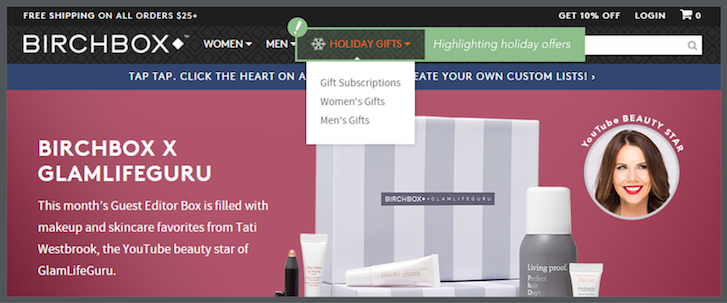 Here, you can see Birchbox going the extra mile with their holiday design by directly addressing the needs of people shopping for holiday gifts.
Here, you can see Birchbox going the extra mile with their holiday design by directly addressing the needs of people shopping for holiday gifts.
Step 2: Plan your insanely-high-value campaign
A regular sale isn’t a great way to stand out and win over new customers (or even earn some brand loyalty with existing ones) - your client will need to step up their game. To help them do so, here’s what you can do to make sure that the expectations of the customers are exceeded:
Create personalized offers
Buyers expect personalization these days - in fact, 70% of them do, according to a survey by AgilOne. To give customers recognition and the personal touch, make use of smart segmentation:
- by demographics and psychographics
- by shopping history
- by average order volume, etc.
Personalization isn’t just appealing, it also makes sense from a marketing standpoint - you don’t want to sell to every customer the same way, but instead to tailor your approach to their buying habits, preferences, and demographics.
Most ecommerce-friendly email service providers should support sophisticated segmentation - if they don’t, consider finding your client a different provider (like Klaviyo), and watch their ROI skyrocket.
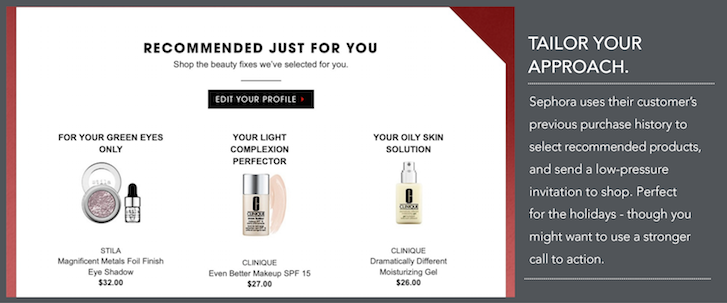
Do something unusual
If your client doesn’t usually offer free shipping, why not offer it on every item during the sale? Learn how to set it up here. There’s a holiday value proposition that will open wallets!
Alternatively, you can help your client organize freebies, festive giveaways, and do lots of other things that build loyalty and add value - all without depreciating their brand.
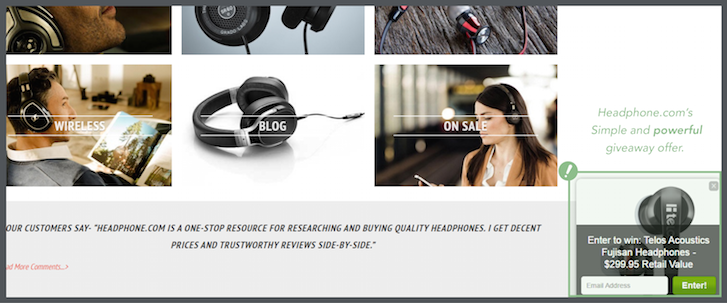 This giveaway offer on Headphone.Com is so simple and compelling that it’s very hard to pass up. And you can easily adapt it for the holiday season.
This giveaway offer on Headphone.Com is so simple and compelling that it’s very hard to pass up. And you can easily adapt it for the holiday season.
Do things that don’t scale
It could be as simple as a holiday postcard with every order… or it could be as involved as a live chat rep standing by, ready to answer people’s concerns and manage objections (Olark can help your client with that last one). Related to personalization, this strategy is incredible when you can’t rely on price cuts alone to move the merchandise.
Use scarcity and urgency
Create timed offers, limit the amount of items that can be bought at a deep discount, and otherwise drive up the perceived value of what your client is selling. You could even help them create a special, holiday-themed option for their most popular product to drive sales… and make it a limited edition.
You can use an app like Behavioral Targeting by Addshoppers to create relevant, high-urgency offers that convert extremely well (even with a 50% lift, according to some case studies).
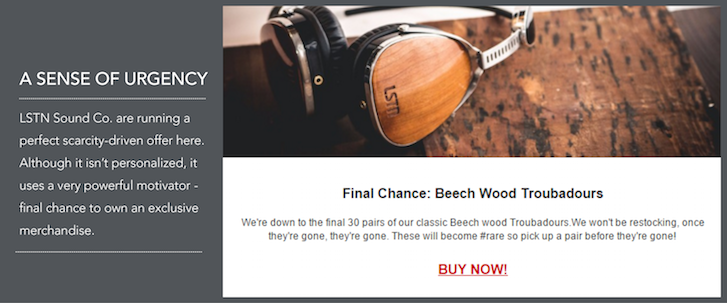
You might also like: 4 Ways to Give Some Holiday Flair to an Ecommerce Store
Step 3: Stretch the long tail
After the holiday bonanza is over, your client will have new customers expecting a stellar experience, and long-time customers who are still in the mood to buy. Not screwing up the long-tail sales is a vital part of a successful holiday marketing strategy.
So let’s see what you can do (which is a lot)!
Get them on a loyalty program
Using tools like Sweet Tooth and other customer loyalty apps makes it very easy to reward customers who stick around and buy again. And because your client will let them know how valued they are, their brand will be top-of-mind for them next holiday season (or before).
Sneak some discounts to non-buyers
Much in the same way as you’d bring people back to an abandoned cart, you can help your client to retarget customers who never bought something.
Just let your client say that, in their book, the holiday isn’t over until everyone has walked off with a precious thing of their own! You can bring non-buyers back in 2 main ways:
- Do a late cart abandonment email after the sale is over (if you have their email address), and offer an exclusive discount - another moment when personalization comes in handy!
- Launch a Facebook retargeting campaign after the sale and bring them back to the product they were viewing.
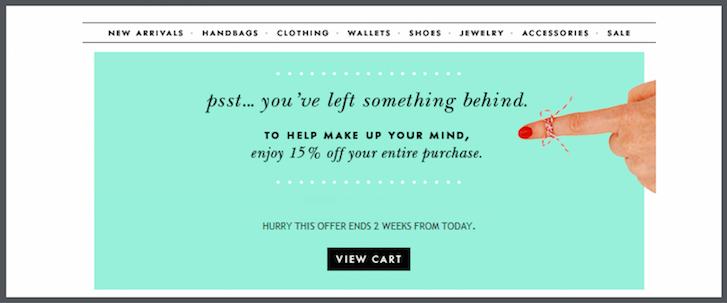 It might take something extra to make people come back and complete their order after the holiday craziness. A time-sensitive 15%, as in this example, should do it!
It might take something extra to make people come back and complete their order after the holiday craziness. A time-sensitive 15%, as in this example, should do it!
Use a personal touch with new customers
Together with your client, try to do things that don’t scale, yet do wonders for customer loyalty. For example, sending a postcard or a small gift with their shipment costs a little extra, true — but if it increases the chances that they gain a long-term customer, it’s an excellent investment.
Another good way for your client to stay connected with new buyers is to ask them for reviews or feedback. A tool like Yotpo can give your client a perfect way to do this in a quick, frictionless manner.
Finally, a third strategy to use would be to design an onboarding sequence that familiarizes a new customer with your client’s brand. It should give them a great reason to stick around and continue to shop in your client’s store.
Have a record-breaking year
Holiday season is an important, exciting, and scary time for your client. By following these 3 steps, you will ensure they have a record-breaking holiday season, and acquire high-quality customers that will buy from them beyond the holidays (and at full prices).
You might also like: 5 Design Tips to Boost Conversions this Holiday Season









